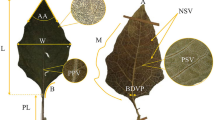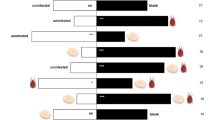Abstract
To examine genetic variation in defensive chemistry within and between natural populations of Plantago lanceolata, we performed a greenhouse experiment using clonal replicates of 15 genotypes from each of two populations, from a mowed lawn and an abandoned hayfield. Replicates of each genotype were harvested for determinations of aboveground biomass and leaf chemical content either at the beginning of the experiment (initial controls), after exposure to herbivory by larvae of Junonia coenia, a specialist on P. lanceolata (herbivory treatment), or at the end of the experiment without exposure to herbivory (final controls). Allocation to the iridoid glycosides aucubin and catalpol and the phenylpropanoid glycoside verbascoside displayed significant genetic variation within and between populations, and differed with leaf age. Significant genotypextreatment interactions indicated genetic variation in response of leaf chemistry to the treatments. There was no evidence for a cost of allocation to chemical defense: genetic correlations within and between chemical pathways and between defensive chemicals and aboveground growth were positive or nonsignificant. Although iridoid glycosides are known to be qualitative feeding stimulants for J. coenia, multiple regression of larval survivorship on leaf chemical content and shoot biomass indicated that larvae had lower survivorship on P. lanceolata ge-notypes with higher concentrations of aucubin in the leaves. Larval survivorship was unaffected by levels of catalpol and verbascoside. Thus, although specialist herbivores may respond to defensive chemicals as qualitative feeding stimulants, they do not necessarily have higher fitness on plant genotypes containing higher concentrations of these chemicals.
Similar content being viewed by others
References
Abrahamson WG, Caswell H (1982) On the comparative allocation of biomass, energy, and nutrients in plants. Ecology 63:982–991
Andary C, Motte-Florac ME, Gargadennec A, Wilde R, Heitz A (1988) Les esters cafeiques du genre Plantago. Identification et valeur chimiotaxonomique. Plant Med Phytother 22:17–22
Ayres MP, Thomas DL (1990) Alternative formulations of the mixed-model ANOVA applied to quantitative genetics. Evolution 44:221–226
Belsky AJ (1986) Does herbivory benefit plants? A review of the evidence. Am Nat 127:870–892
Berenbaum MR, Zangerl AR, Nitao JK (1986) Constraints on chemical coevolution: wild parsnips and the parsnip webworm. Evolution 40:1215–1228
Blum MS (1983) Detoxification, deactivation, and utilization of plant compounds by insects. In: Hedin PA (ed) Plant resistance to insects. American Chemical Society, Washington, D.C. pp 265–275
Bordner J, Danehower DA, Thacker JD, Kennedy GG, Stinner RE, Wilson KG (1983) Chemical basis for host selection. In: Hedin PA (ed) Plant resistance to insects. American Chemical Society, Washington D.C., pp 245–264
Bowers MD (1983) The role of iridoid glycosides in host-plant specificity of checkerspot butterflies. J Chem Ecol 9:475–493
Bowers MD (1984) Iridoid glycosides and host-plant specificity in larvae of the buckeye butterfly, Junonia coenia (Nymphalidae) J Chem Ecol 10:1567–1577
Bowers MD (1988) Plant allelochemistry and mimicry. In: Barbosa P, Letourneau D (eds), Novel aspects of insect-plant interactions. Wiley, pp 273–311
Bowers MD, Collinge SK (1992) Fate of iridoid glycosides in different life stages of the buckeye, Junonia coenia (Lepidoptera: Nymphalidae). J Chem Ecol 18:817–831
Bowers MD, Puttick GM (1988) Response of generalist and specialist insects to qualitative allelochemical variation. J Chem Ecol 14:319–334
Bowers MD, Puttick GM (1989) Iridoid glycosides and insect feeding preferences: gypsy moths (Lymantria dispar, Lymantriidae) and buckeyes (Junonia coenia, Nymphalidae) Ecol Entomol 14:247–256
Bowers MD, Stamp NE (1992) Chemical variation within and between individuals of Plantago lanceolata (Plantaginaceae). J Chem Ecol 18:985–995
Bowers MD, Stamp NE (1993) Effects of plant age, genotype, and herbivory on Plantago performance and chemistry. Ecology 74:1778–1791
Bowers MD, Collinge SK, Gamble SE, Schmitt J (1992) Effects of genotypes, habitat, and seasonal variation on iridoid glycoside content of Plantago lanceolata (Plantaginaceae) and the implications for insect herbivores. Oecologia 91:201–207
Brown DG (1988) The cost of plant defense: an experimental analysis with inducible proteinase inhibitors in tomato. Oecologia 76:467–470
Chew FS, Rodman JE (1979) Plant resources for chemical defense. In: Rosenthal GA, Janzen DH (eds) Herbivores: their interaction with secondary plant metabolites. Academic Press, New York, pp 271–301
Coley PD (1986) Costs and benefits of defense by tannins in a neotropical tree. Oecologia 70:238–241
Crawley MJ (1989) Insect herbivores and plant population dynamics. Annu Rev Entomol 34:531–564
Dement WA, Mooney HA (1974) Seasonal variation in the production of tannins and cyanogenic glucosides in the chaparral shrub, Heteromeles arbutifolia. Oecologia 15:65–76
Dolinger PM, Ehrlich PR, Fitch WL, Breedlove DE (1973) Alkaloid and predation patterns in Colorado lupine populations. Oecologia 13:191–204
Duff RB, Bacon JSD, Mundie CM, Farmer VC, Russel JD, Forrester AR (1965) Catalpol and methylcatalpol: naturally occurring glycosides in Plantago and Buddleia species. Biochem J 96:1–5
El-Naggar LJ, Beal JL (1980) Tridoids. A review. J Nat Prod 43:649–707
Fajer ED, Bowers MD, Bazzaz FA (1992) The effect of nutrients and enriched CO2 environments on production of carbon-based allelochemicals in Plantago: a test of the carbon/nutrient balance hypothesis. Am Nat 140:707–723
Feeny P (1970) Seasonal changes in oak leaf tannins and nutrients as a cause of spring feeding by winter moth caterpillars. Ecology 51:565–581
Fry JD (1992) The mixed-model analysis of variance applied to quantitative genetics: biological meaning of the parameters. Evolution 46:540–550
Gardner DR, Stermitz FR (1988) Host plant utilization and iridoid glycoside sequestration by Euphydryas anicia (Lepidoptera: Nymphalidae). J Chem Ecol 14:2147–2168
Geber MA (1991) The cost of meristem limitation in Polygonum arenastrum negative genetic correlations between fecundity and growth. Evolution 44:799–819
Gouyon PH, Fort PH, Caraux G (1983) Selection of seedlings of Thymus vulgaris by grazing slugs. J Ecol 71:299–306
Hanover JW (1966) Genetics of terpenes. I. Gene control of monoterpene levels in Pinus monticola Dougl. Heredity 21:73–84
Harper JL (1989) The value of a leaf. Oecologia 80:53–58
Houle D (1991) Genetic covariance of fitness correlates: what genetic correlations are made of and why it matters. Evolution 45:630–648
Ikeda T, Matsumura F, Benjamin DM (1977) Chemical basis for feeding adaptation of pine sawflies Neodiprion rugifrons and Neodiprion swainei. Science 197:497–499
Jensen SR, Nielsen BJ, Dahlgren R (1975) Iridoid compounds, their occurrence and systematic importance in the angiosperms. Bot Not 128:148–180
Jones SB, Burnett WC Jr, Coile NC, Mabry TJ, Betkouski MF (1979) Sesquiterpene lactones of Vernonia-influence of glaucodide-A on the growth rate and survival of lepidopterous larvae. Oecologia 39:71–77
Karban R (1993) Costs and benefits of induced resistance and plant density for a native shrub, Gossypium thurberi. Ecology 74:9–19
Kraft SA, Denno RF (1982) Feeding responses of adapted and non-adapted insects to the defensive properties of Baccharis halimifolia L. (Compositae). Oecologia 52:156–163
Krischik VA, Denno RF (1983) Individual, population, and geographic patterns in plant defense. In: Denno RF, McClure MS (ed), Variable plants and herbivores in natural and managed systems. Academic Press, New York, pp 463–512
Lincoln DE, Murray MJ (1978) Monogenic basis for reduction of (+)-pulegone to (−)-menthone in Mentha oil biogenesis. Phytochemistry 17:1727–1730
Lincoln DE, Newton TS, Ehrlich PR, Williams KS (1982) Coevolution of the checkerspot butterfly Euphydryas chalcedona and its larval food plant Diplacus aurantiacus: larval response to protein and leaf resin. Oecologia 52:216–223
Lincoln DE, Murray MJ, Lawrence BM (1986) Chemical composition and genetic basis for the isopinocamphone chemotype of Mentha citrata hybrids. Phytochemistry 25:1857–1863
Maddox GD, Cappuccino N (1986) Genetic determination of plant susceptibility to an herbivorous insect depends on environmental context. Evolution 40:863–866
Marquis RJ (1984) Leaf herbivores decrease fitness of a tropical plant. Science 226:537–539
Marquis RJ (1990) Genotypic variation in leaf damage in Piper arieianum (Piperaceae) by a multispecies assemblage of herbivores. Evolution 44:104–120
Metcalf RL, Rhodes AM, Metcalf RA, Ferguson J, Metcalf ER, Lu PY (1982) Cucurbitacin contents and diabroticite (Coleoptera: Chrysomelidae) feeding upon Cucurbita spp. Environ Entomol 11:931–937
Mitter C, Futuyma DJ (1983) An evolutionary-genetic view of host-plant utilization by insects. In: Denno RF, McClure MS (eds), Variable plants and herbivores in natural and managed systems. Academic Press, New York, pp 427–459
Molgaard P (1986) Population genetics and geographical distribution of caffeic acid esters in leaves of Plantago major in Denmark. J Ecol 74:1127–1137
Mooney HA, Ehrlich PR, Lincoln DE, Williams KS (1980) Environmental controls on the seasonality of a drought deciduous shrub, Diplacus aurantiacus and its predator the checkerspot butterfly, Euphydryas chalcedona. Oecologia 45:143–146
Mooney HA, Williams KS, Lincoln DE, Ehrlich PR (1981) Temporal and spatial variability in the interaction between the checkerspot butterfly, Euphydryas chalcedona and its principal food source, the Californian shrub, Diplacus aurantiacus. Oecologia 50:195–198
Moran N (1981) Intraspecific variability in herbivore performance and host quality: a field study of Uroleucon caligatum (Homoptera: Aphididae) and its Solidago hosts (Asteraceae). Ecol Entomol 6:301–306
Morrow PA, LaMarche Jr VC (1978) Tree ring evidence for chronic insect suppression of productivity in subalpine Eucalyptus. Science 201:1244–1246
Murray MJ, Lincoln DE, Hefendehl FW (1980) Chemogenetic evidence supporting multiple allele control of the biosynthesis of (−)-menthone and (+)-isomenthone stereoisomers in Mentha species. Phytochem 19:2103–2110
Noordwijk AJ van, Jong G de (1986) Acquisition and allocation of resources: their influence on variation in life history traits. Am Nat 128:137–142
Pereyra PC, Bowers MD (1988) Iridoid glycosides as oviposition stimulants for the buckeye butterfly, Junonia coenia (Nymphalidae). J Chem Ecol 14:917–928
Pilson D (1992) Relative resistance of goldenrod to aphid attack: changes through the growing season. Evolution 46: 1230–1236
Rausher MD, Feeny P (1980) Herbivory, plant density, and plant reproductive success: the effect of Battus philenor on Aristolochia reticulata. Ecology 61:905–917
Ravn H, Brimer L (1988) Structure and antibacterial activities of plantamajoside, a caffeic acid sugar ester from Plantago major ssp. major. Phytochem 27:3433–3437
Rausher MD, Simms EL (1989) The evolution of resistance to herbivory in Ipomoea purpurea. I. Attempts to detect selection. Evolution 43:563–572
Rice WR (1989) Analyzing tables of statistical tests. Evolution 43:223–225
Sacchi CF, Price PW, Craig TP, Itami JK (1988) Impact of shoot galler attack on sexual reproduction in the arroyo willow. Ecology 69:2021–2030
SAS Institute (1982) User's guide. SAS Institute, Cary
Schultz JC, Nothnagle PJ, Baldwin IT (1982) Seasonal and individual variation in leaf quality of two northern hardwoods tree species. Am J Bot 69:753–759
Service P (1984) Genotypic interaction in an aphid-host relationship: Uroleucon rudbeckiae and Rudbeckia laciniata. Oecologia 61:271–276
Simms EL (1992) Costs of plant resistance to herbivory. In: Fritz RS, Simms EL (eds) Plant resistance to herbivores and pathogens. University of Chicago Press, Chicago, pp 392–425
Simms EL, Rausher MD (1987) Costs and benefits of plant resistance to herbivory. Am Nat 130:570–581
Simms EL, Rausher MD (1989) The evolution of resistance to herbivory in Ipomoea purpurea. II. Natural selection by insects and costs of resistance. Evolution 43:573–585
Thorsteinson AJ (1960) Host selection in phytophagous insects. Annu Rev Entomol 5:193–218
Troelstra SR, Brouwer R (1992) Mineral nutrient concentrations in the soil and in the plant. In: Kuiper PJC Bos M (eds). Plantago: a multidisciplinary study. Springer, Berlin Heidelberg New York, pp 122–137
Vrieling K, Smit W, Meijden E van der (1991) Tritrophic interactions between aphids (Aphis jacobaeae Schrank), and species, Tyria jacobaeae L., and Senecio jacobaea L. lead to maintenance of genetic variation in pyrrolizidine alkaloid concentration. Oecologia 86:177–182
Author information
Authors and Affiliations
Rights and permissions
About this article
Cite this article
Adler, L.S., Schmitt, J. & Bowers, M.D. Genetic variation in defensive chemistry in Plantago lanceolata (Plantaginaceae) and its effect on the specialist herbivore Junonia coenia (Nymphalidae). Oecologia 101, 75–85 (1995). https://doi.org/10.1007/BF00328903
Received:
Accepted:
Issue Date:
DOI: https://doi.org/10.1007/BF00328903




